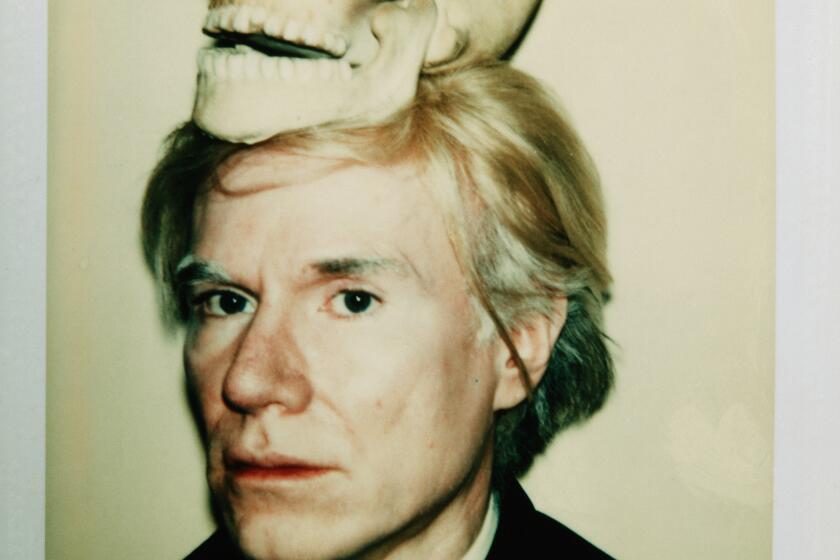Review: Come for the Warhols, stay for the cars at the late artist’s Petersen Automotive show
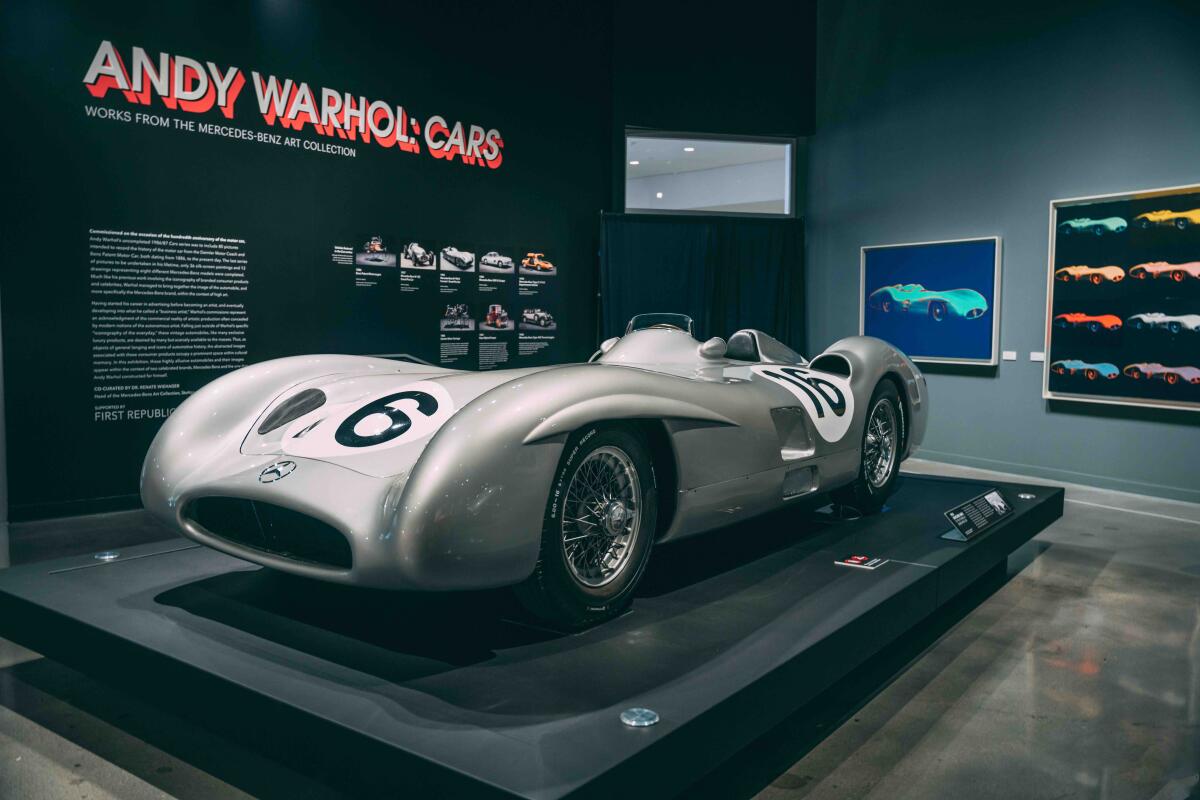
- Share via
In 1986, celebrating the company’s centennial, Mercedes-Benz hired Andy Warhol to paint 20 notable automobiles that the luxury German car company had manufactured since 1886. If Warhol could do up Mao and Queen Elizabeth, why not a legendary W 125 Grand Prix racer? Art collecting was experiencing a high-profile boom in Germany and engaging a famous international artist to execute a sort of commercial corporate update on a celebrity tradition of aristocratic portraiture was a clever marketing plan.
Tragedy derailed it.
Warhol was a bit less than halfway through the lavish commission when he died, suddenly and unexpectedly, at just 58. The artist finished work on only eight of the cars before he succumbed, following major gallbladder surgery, in February 1987. Until now, the paintings have not been shown together in the United States.
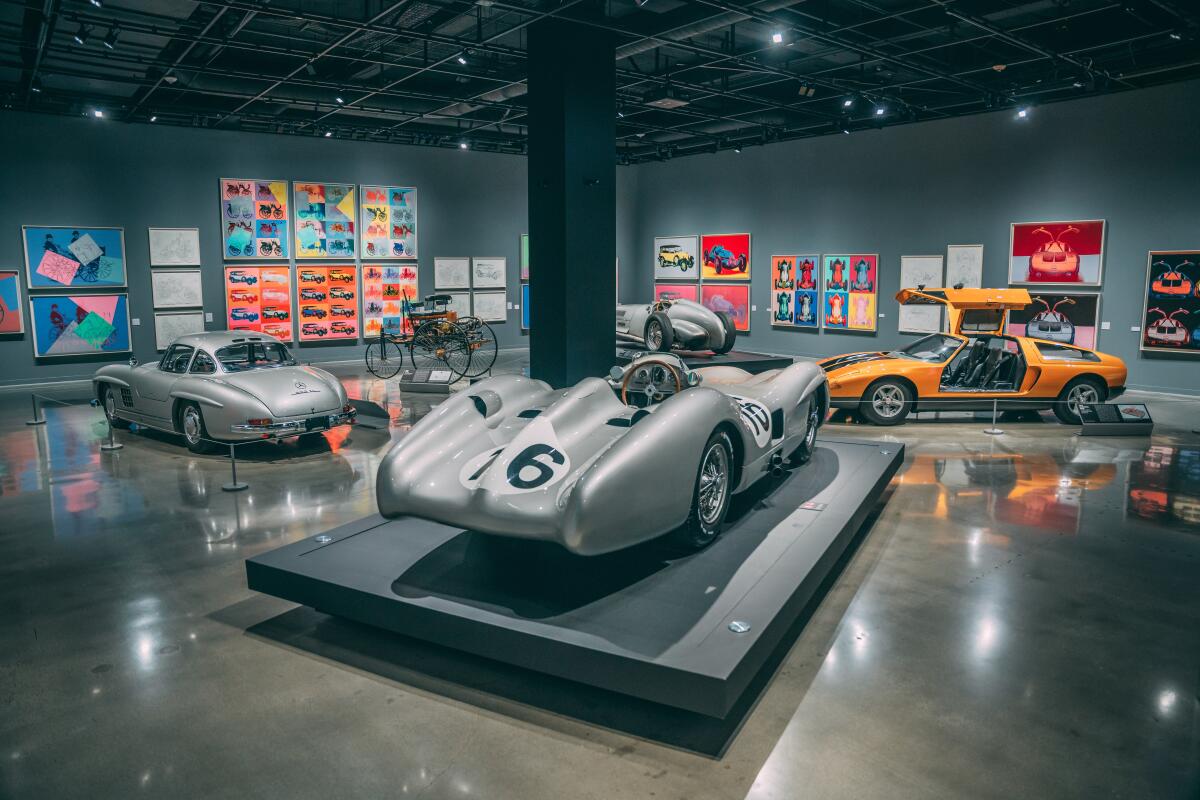
)
Twenty-seven of the 36 completed silkscreen paintings (80 were planned) and all 13 pencil drawings are currently on display at the Petersen Automotive Museum on Wilshire Boulevard, where “Andy Warhol: Cars — Works from the Mercedes-Benz Art Collection” has just opened in the first-floor gallery. (The show was co-organized by the Petersen and Mercedes-Benz curator Renate Wiehager.) The art is paired with five of the eight models of vehicle depicted in the paintings. As with much of what Warhol painted in the late 1970s and 1980s, after the nearly faultless run of superlative, art-history-changing works he produced between about 1961 and 1968, the Mercedes paintings are banal. The vehicles, on the other hand, range from fascinating to extraordinary.
Come for the Warhols, stay for the cars.
And I say that knowing that cars are not my area of expertise. I know only one thing about them for certain, and that is that my engineer grandfather designed a magneto for the Ford Model A, which replaced the hugely successful Model T in 1928. End of deep comprehension.
But I also know this: There’s a drop-dead gorgeous 1954 Mercedes-Benz 300 SL Gullwing coupe, a silver model with a royal blue leather interior and matching leather suitcase strapped into the rear deck, where it can be covetously ogled through the back window. Hanging adjacent are Warhol’s perfectly pretty, decidedly snoozy portraits of it. If given a choice between the car and a painting, I’d take the car in a heartbeat.
Warhol I’ve got a better grip on, and these silkscreen paintings are pretty much a flop. They look like ordinary posters for a teenager’s bedroom. An insurmountable dissonance, which takes some explaining, undermines them.
As he did with virtually all of his paintings after the classic 1962 pictures of Marilyn Monroe became a sensation, Warhol used standard commercial photographs to make the basic silkscreen images that he printed on canvas. A helpful short film clip in the exhibition shows him printing an Elvis Presley painting with the help of Gerard Malanga, the studio assistant who did much of the labor on Warhol’s early work. The canvas might start by being painted in a solid acrylic color, or sometimes multiple hues applied in various shapes, with the screen image printed over that. The drawings were made to elaborate the details.
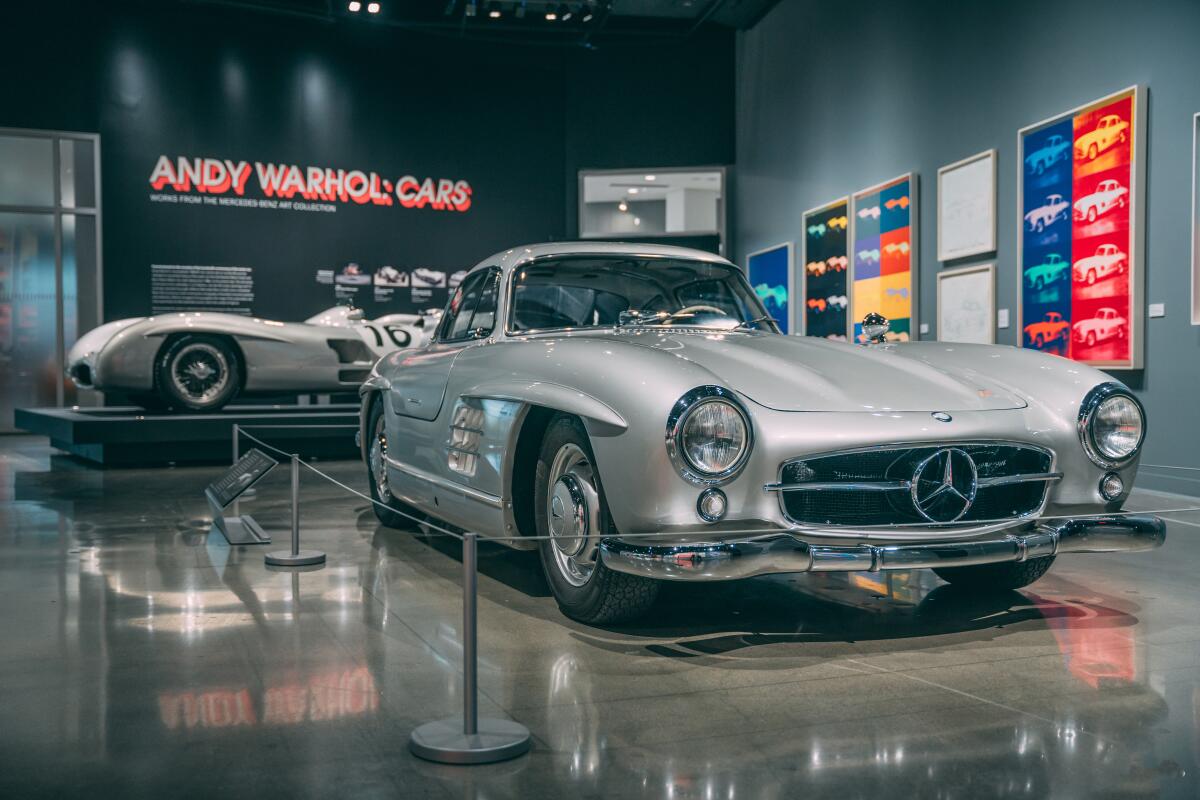
Warhol had tremendous style, but he wasn’t much of a draftsman. The car drawings were likely made using an opaque projector. The photo for the silkscreen would be projected onto a sheet of paper and the car’s contour outlines traced. These became secondary photo-silkscreens to be overlaid on the painted canvas, printed in other colors for visual interest. Some of the paintings are single images, others are divided into grids of four, eight or 12 repeated pictures.
Warhol’s technique doesn’t come from traditional studio painting practice. Instead, it has two sources — one professional, one personal. Professionally, it was an inventive adaptation of commercial printing processes that derive from photographs — something he knew well from his hugely successful career in Madison Avenue advertising. Personally, it was born of America’s gay subculture, which the artist knew equally well.
The six-part Ryan Murphy Netflix series doesn’t tackle Andy Warhol’s revolutionary 1960s work, but rather the relationships that were meaningful to him.
How does an ordinary photo turn into a painting? Warhol’s answer: By making paintings that are photographs in drag.
The photograph is the equivalent of a fresh and untouched face — a given. Acrylic colors are like makeup — the foundation and lipstick, the mascara and rouge, the wig and jewels.
The difference between the photograph and the painting was like the difference between plain old boy-next-door James Slattery and exquisite Candy Darling, to name Slattery’s transformation into the most beautiful cinematic superstar working in Warhol’s Factory. Drag could transform a bland black-and-white photo into a glamorous painting.
The problem with the Mercedes commission is not that the cars started out with beauty already on their side, so that the paintings had nothing much to do. In the show, the luxe 300 SL, a remarkable streamlined 1954 Formula One Grand Prix car and a low-slung fiberglass 1970 experimental model, also with up-swooping gullwing doors, are surely among the 20th century’s most aesthetically pleasing cars. But Marilyn, Jackie Kennedy and Elizabeth Taylor weren’t exactly homely before Warhol did his great silkscreen number on their photographs in the 1960s.
The issue, I think, instead has something to do with gender.
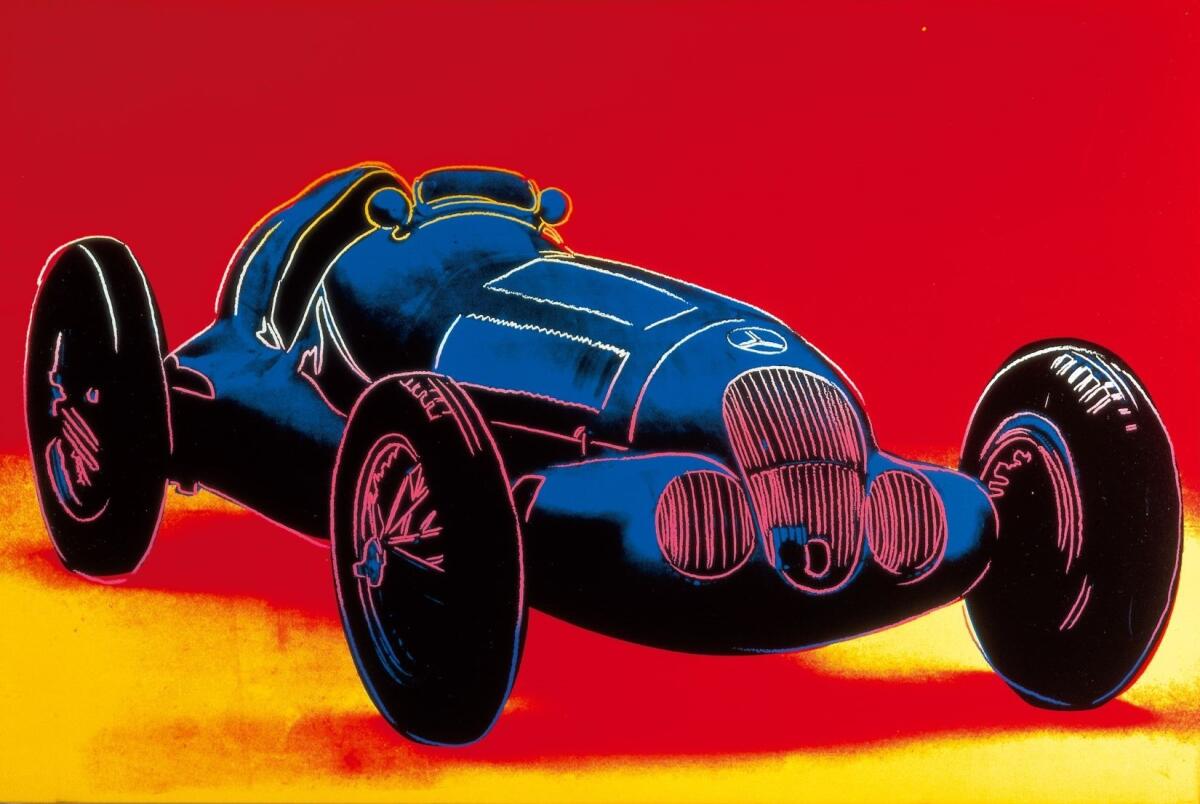
In binary American culture, the arts are collectively gendered female. Few would acknowledge it, but they have always been for girls, which drag represented. A Warhol painting offered captivating exposure of an obscured cultural truth, not resistance to it. And he could successfully use drag to paint entertainment celebrities of any kind, whether Marilyn and Liz or Elvis and Muhammad Ali, because when he was done, the transformation from photo to painting was lateral: What began as entertainment remained an entertainment.
Cars, on the other hand, are gendered male by American culture — the individualized manifestation of the modern industrial dynamo. Automobiles resist Warhol’s lateral drag transformation. The gussied-up paintings just look silly, at best, and irrelevant, at worst. The problem stumped him.
Three photo-silkscreen canvases show Gottlieb Daimler or Karl Benz, engineers and founders of the companies that would later become Mercedes-Benz, riding in an 1886 Daimler Motor Carriage, which is generally considered the first automobile. (An intriguing replica model stands nearby — a 19th century carriage-without-a-horse.) They’re the only paintings with people. But Warhol’s color-blocking attempt to update old-timey photographs into something artfully abstract and modern fails, looking instead like C-minus fliers from an undergraduate design class.
The remaining paintings are mostly just dull, with a squiggle of color here and a flourish of flash there, merely dressing up a conventional photo of a car. Looking at them, I kept thinking of a loosely related Warhol project — his great 1963/64 car-crash paintings. Those are not glamour cars. Photographs gleaned from the tabloid press instead show cars wrecked and upside down, mangled bodies dangling and strewn about.
Andy Warhol’s iconic ‘Shot Sage Blue Marilyn,’ which sold for $195 million Monday night, is the most expensive 20th century artwork ever bought at auction.
In them Warhol was picturing a founding myth of the New York School — that the strutting virility of Jackson Pollock, infamously killed in a drunken 1956 automobile accident on Long Island, was instrumental to an American acceptance of the “girlish” category of art as a Cold War global triumph. His magnificent, ethereal drip-paintings weren’t enough on their own; they needed a backstory that was butch. Pollock’s ruin merged with movie star James Dean’s, also killed in a wreck. Civil rights movements were gathering force in the 1960s, and the arrogant, exclusionary, straight white machismo driving 1950s American culture was brilliantly exposed — and neutered — through an effeminate homosexual artist’s application of drag.
Nothing close to that power happens with the abbreviated Mercedes-Benz commission. But, boy, are the cars in the gallery stunning! As a bonus, Warhol’s own elegant, two-tone 1974 Rolls-Royce Silver Shadow is parked out in the museum lobby. His name is emblazoned on the New York vanity plates, front and back. It’s worth knowing that the artist didn’t have a license and never drove it; but, like a painting, the artist’s car is effectively signed.
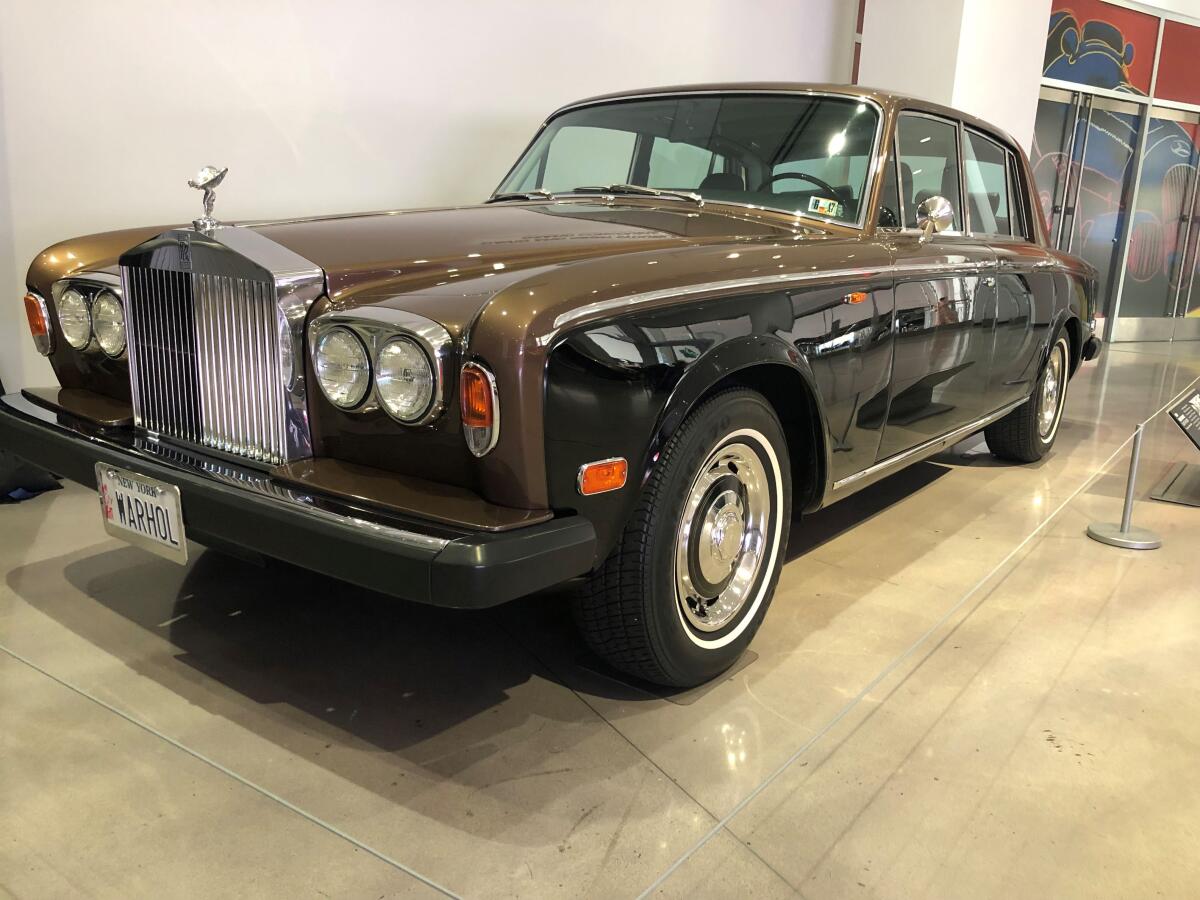
'Andy Warhol: Cars — Works from the Mercedes-Benz Art Collection'
Where: Petersen Automotive Museum, 6060 Wilshire Blvd.
When: Monday-Sunday, 10 AM - 5 PM. Through Jan. 22.
Info: (323-930-CARS), www.petersen.org
More to Read
The biggest entertainment stories
Get our big stories about Hollywood, film, television, music, arts, culture and more right in your inbox as soon as they publish.
You may occasionally receive promotional content from the Los Angeles Times.
